window PEUGEOT 2008 2014 Owners Manual
[x] Cancel search | Manufacturer: PEUGEOT, Model Year: 2014, Model line: 2008, Model: PEUGEOT 2008 2014Pages: 336, PDF Size: 9.35 MB
Page 4 of 336
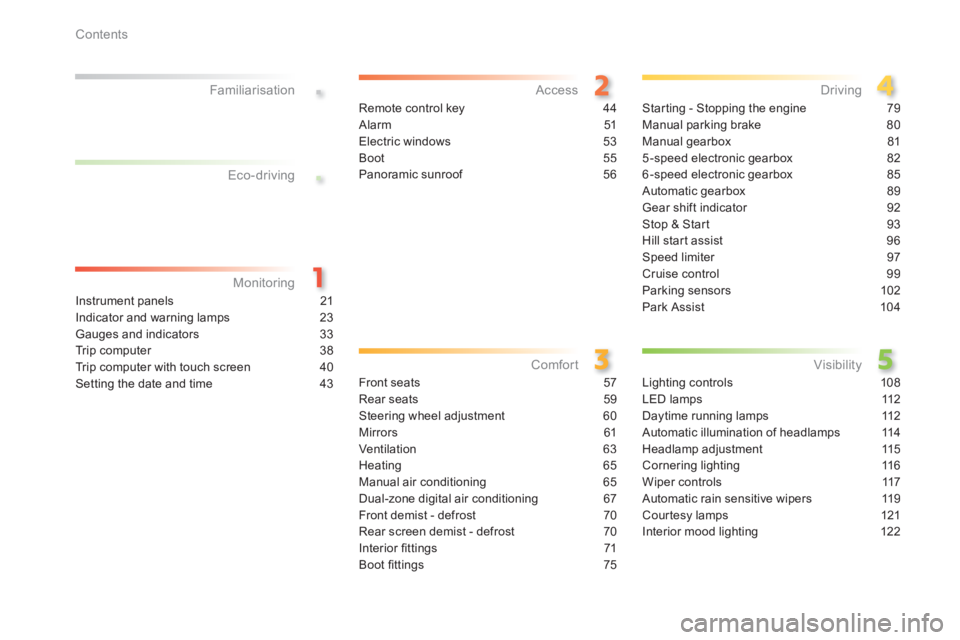
.
.
Contents
Instrument panels 21
Indicator and warning lamps 23
Gauges and indicators 33
Trip computer 38
Trip computer with touch screen 40
Setting the date and time 43
Monitoring
Familiarisation
Remote control key
44
Alarm 51
Electric windows 53
Boot 55
Panoramic sunroof 56
Access
Front seats 57
Rear seats 59
Steering wheel adjustment 60
Mirrors 61
Ventilation 63
Heating 65
Manual air conditioning 65
Dual-zone digital air conditioning 67
Front demist - defrost 70
Rear screen demist - defrost 70
Interior fi ttings 71
Boot fi ttings 75
Comfort
Starting - Stopping the engine 79
Manual parking brake 80
Manual gearbox 81
5-speed electronic gearbox 82
6-speed electronic gearbox 85
Automatic gearbox 89
Gear shift indicator 92
Stop & Start 93
Hill start assist 96
Speed limiter 97
Cruise control 99
Parking sensors 102
Park Assist 104
Driving
Lighting controls 108
LED lamps 112
Daytime running lamps 112
Automatic illumination of headlamps 114
Headlamp adjustment 115
Cornering lighting 116
Wiper controls 117
Automatic rain sensitive wipers 119
Courtesy lamps 121
Interior mood lighting 122
Visibility
Eco-driving
Page 10 of 336
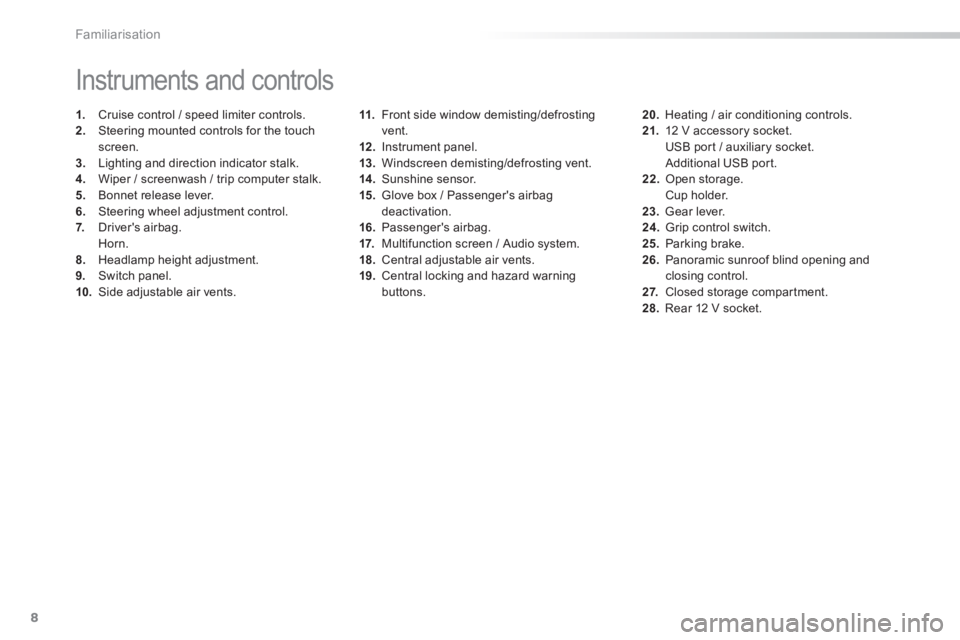
8Familiarisation
11. Front side window demisting/defrosting vent. 12 . Instrument panel. 13. Windscreen demisting/defrosting vent. 14 . Sunshine sensor. 15. Glove box / Passenger's airbag deactivation. 16. Passenger's airbag. 17. Multifunction screen / Audio system. 18. Central adjustable air vents. 19. Central locking and hazard warning buttons.
Instruments and controls
1. Cruise control / speed limiter controls. 2. Steering mounted controls for the touch screen. 3. Lighting and direction indicator stalk .4. Wiper / screenwash / trip computer stalk. 5. Bonnet release lever. 6. Steering wheel adjustment control. 7. Driver's airbag. Horn. 8. Headlamp height adjustment. 9. Switch panel. 10. Side adjustable air vents.
20. Heating / air conditioning controls. 21. 12 V accessory socket. USB port / auxiliary socket. Additional USB port. 22. Open storage. Cup holder. 23. Gear lever. 24. Grip control switch. 25. Parking brake. 26. Panoramic sunroof blind opening and closing control. 2 7. Closed storage compartment. 28. Rear 12 V socket.
Page 21 of 336
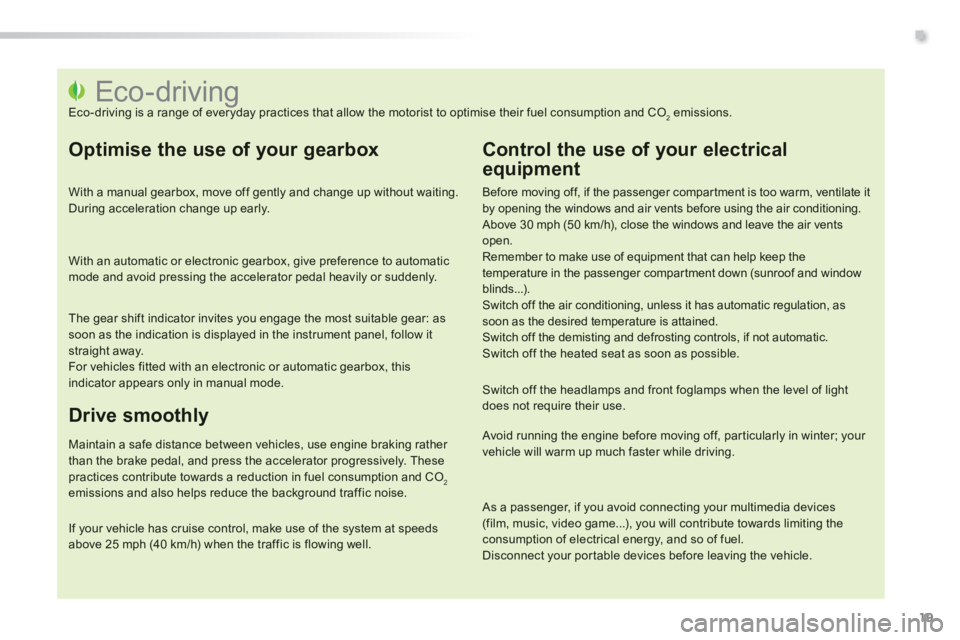
.
19
Eco-driving Eco-driving is a range of everyday practices that allow the motorist to optimise their fuel consumption and CO2 emissions.
Optimise the use of your gearbox
With a manual gearbox, move off gently and change up without waiting. During acceleration change up early.
With an automatic or electronic gearbox, give preference to automatic mode and avoid pressing the accelerator pedal heavily or suddenly.
The gear shift indicator invites you engage the most suitable gear: as soon as the indication is displayed in the instrument panel, follow it straight away. For vehicles fitted with an electronic or automatic gearbox, this indicator appears only in manual mode.
Drive smoothly
Maintain a safe distance between vehicles, use engine braking rather than the brake pedal, and press the accelerator progressively. These practices contribute towards a reduction in fuel consumption and CO2emissions and also helps reduce the background traffic noise.
If your vehicle has cruise control, make use of the system at speeds above 25 mph (40 km/h) when the traffic is flowing well.
Control the use of your electrical
equipment
Before moving off, if the passenger compartment is too warm, ventilate it by opening the windows and air vents before using the air conditioning. Above 30 mph (50 km/h), close the windows and leave the air vents open. Remember to make use of equipment that can help keep the temperature in the passenger compartment down (sunroof and window blinds...). Switch off the air conditioning, unless it has automatic regulation, as soon as the desired temperature is attained. Switch off the demisting and defrosting controls, if not automatic. Switch off the heated seat as soon as possible.
Switch off the headlamps and front foglamps when the level of light does not require their use.
Avoid running the engine before moving off, particularly in winter; your vehicle will warm up much faster while driving.
As a passenger, if you avoid connecting your multimedia devices (film, music, video game...), you will contribute towards limiting the
consumption of electrical energy, and so of fuel. Disconnect your portable devices before leaving the vehicle.
Page 47 of 336
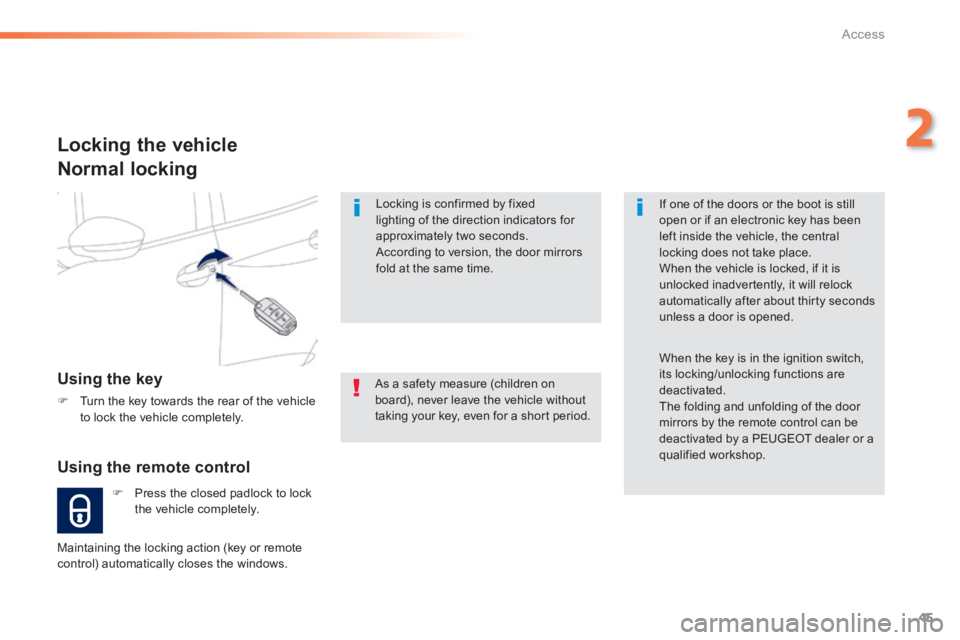
45
2
Access
Locking is confirmed by fixed lighting of the direction indicators for approximately two seconds. According to version, the door mirrors fold at the same time.
As a safety measure (children on board), never leave the vehicle without taking your key, even for a short period.
Locking the vehicle
Normal locking
Using the remote control
Press the closed padlock to lock the vehicle completely.
Using the key
Turn the key towards the rear of the vehicle to lock the vehicle completely.
Maintaining the locking action (key or remote control) automatically closes the windows.
If one of the doors or the boot is still open or if an electronic key has been left inside the vehicle, the central locking does not take place. When the vehicle is locked, if it is unlocked inadvertently, it will relock automatically after about thirty seconds unless a door is opened.
When the key is in the ignition switch, its locking/unlocking functions are deactivated. The folding and unfolding of the door mirrors by the remote control can be
deactivated by a PEUGEOT dealer or a qualified workshop.
Page 53 of 336
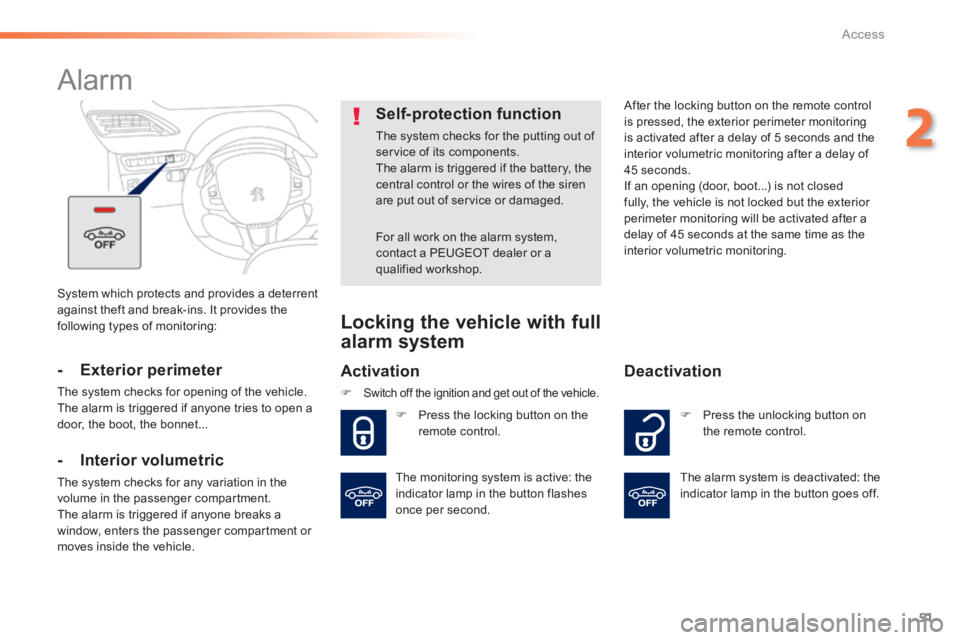
51
2
Access
System which protects and provides a deterrent against theft and break-ins. It provides the following types of monitoring:
Alarm
- Exterior perimeter
The system checks for opening of the vehicle. The alarm is triggered if anyone tries to open a door, the boot, the bonnet...
- Interior volumetric
The system checks for any variation in the volume in the passenger compartment. The alarm is triggered if anyone breaks a window, enters the passenger compartment or
moves inside the vehicle.
Self-protection function
The system checks for the putting out of service of its components. The alarm is triggered if the battery, the central control or the wires of the siren are put out of service or damaged.
For all work on the alarm system, contact a PEUGEOT dealer or a qualified workshop.
Locking the vehicle with full
alarm system
Activation
Switch off the ignition and get out of the vehicle.
Press the locking button on the remote control.
After the locking button on the remote control is pressed, the exterior perimeter monitoring is activated after a delay of 5 seconds and the interior volumetric monitoring after a delay of 45 seconds. If an opening (door, boot...) is not closed fully, the vehicle is not locked but the exterior perimeter monitoring will be activated after a
delay of 45 seconds at the same time as the interior volumetric monitoring.
Press the unlocking button on the remote control.
Deactivation
The alarm system is deactivated: the indicator lamp in the button goes off. The monitoring system is active: the indicator lamp in the button flashes once per second.
Page 54 of 336
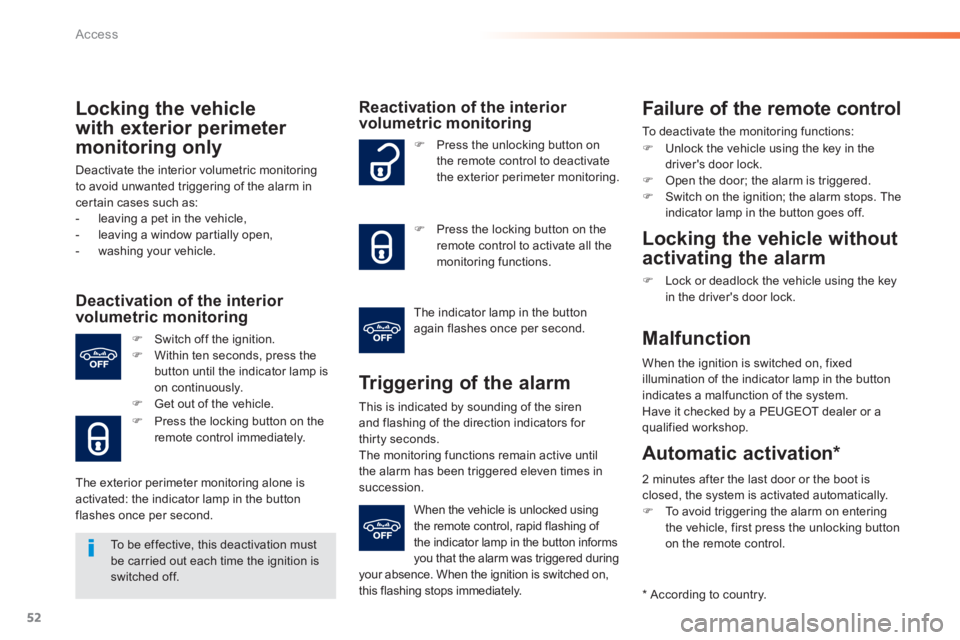
52
Access
Locking the vehicle
with exterior perimeter
monitoring only
Deactivate the interior volumetric monitoring to avoid unwanted triggering of the alarm in certain cases such as: - leaving a pet in the vehicle, - leaving a window partially open, - washing your vehicle.
Deactivation of the interior volumetric monitoring
Switch off the ignition. Within ten seconds, press the button until the indicator lamp is on continuously. Get out of the vehicle.
Press the locking button on the remote control immediately.
The exterior perimeter monitoring alone is activated: the indicator lamp in the button flashes once per second.
Reactivation of the interior volumetric monitoring
Triggering of the alarm
This is indicated by sounding of the siren and flashing of the direction indicators for
thirty seconds. The monitoring functions remain active until the alarm has been triggered eleven times in succession.
Press the unlocking button on the remote control to deactivate the exterior perimeter monitoring.
Press the locking button on the remote control to activate all the monitoring functions.
The indicator lamp in the button again flashes once per second.
When the vehicle is unlocked using the remote control, rapid flashing of the indicator lamp in the button informs you that the alarm was triggered during your absence. When the ignition is switched on, this flashing stops immediately.
Failure of the remote control
To deactivate the monitoring functions:
Unlock the vehicle using the key in the driver's door lock. Open the door; the alarm is triggered. Switch on the ignition; the alarm stops. The indicator lamp in the button goes off.
Locking the vehicle without
activating the alarm
Lock or deadlock the vehicle using the key in the driver's door lock.
Malfunction
When the ignition is switched on, fixed illumination of the indicator lamp in the button indicates a malfunction of the system. Have it checked by a PEUGEOT dealer or a qualified workshop.
* According to country.
Automatic activation *
2 minutes after the last door or the boot is closed, the system is activated automatically. To avoid triggering the alarm on entering the vehicle, first press the unlocking button on the remote control. To be effective, this deactivation must be carried out each time the ignition is switched off.
Page 55 of 336
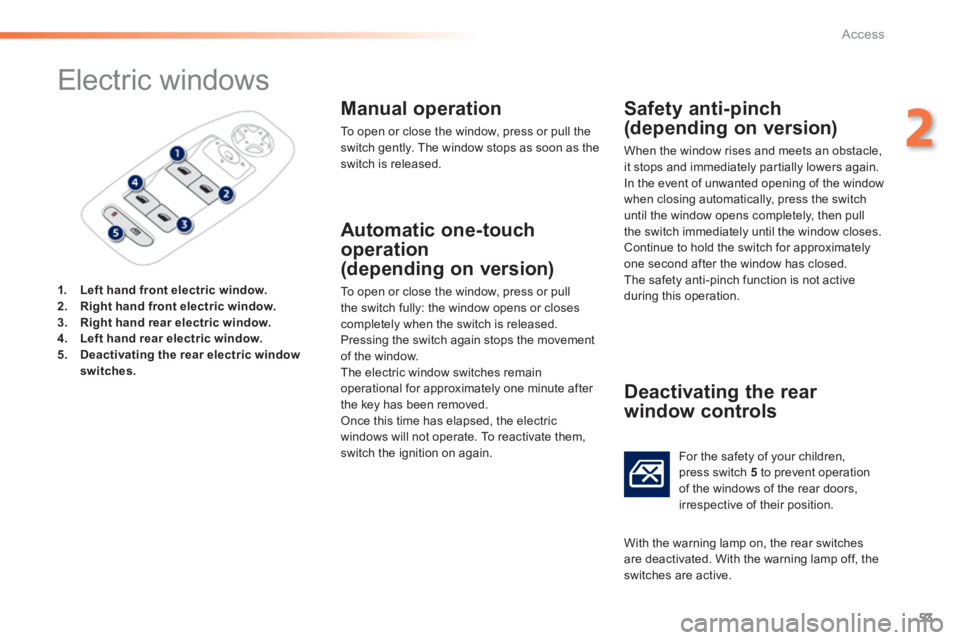
53
2
Access
Electric windows
1. Left hand front electric window.2. Right hand front electric window.3. Right hand rear electric window.4. Left hand rear electric window.5. Deactivating the rear electric window switches.
Manual operation
To open or close the window, press or pull the switch gently. The window stops as soon as the switch is released.
Automatic one-touch
operation
(depending on version)
To open or close the window, press or pull the switch fully: the window opens or closes completely when the switch is released. Pressing the switch again stops the movement of the window. The electric window switches remain operational for approximately one minute after the key has been removed. Once this time has elapsed, the electric windows will not operate. To reactivate them, switch the ignition on again.
Safety anti-pinch
(depending on version)
When the window rises and meets an obstacle, it stops and immediately partially lowers again. In the event of unwanted opening of the window when closing automatically, press the switch until the window opens completely, then pull
the switch immediately until the window closes. Continue to hold the switch for approximately one second after the window has closed. The safety anti-pinch function is not active during this operation.
Deactivating the rear
window controls
For the safety of your children, press switch 5 to prevent operation of the windows of the rear doors, irrespective of their position.
With the warning lamp on, the rear switches are deactivated. With the warning lamp off, the switches are active.
Page 56 of 336
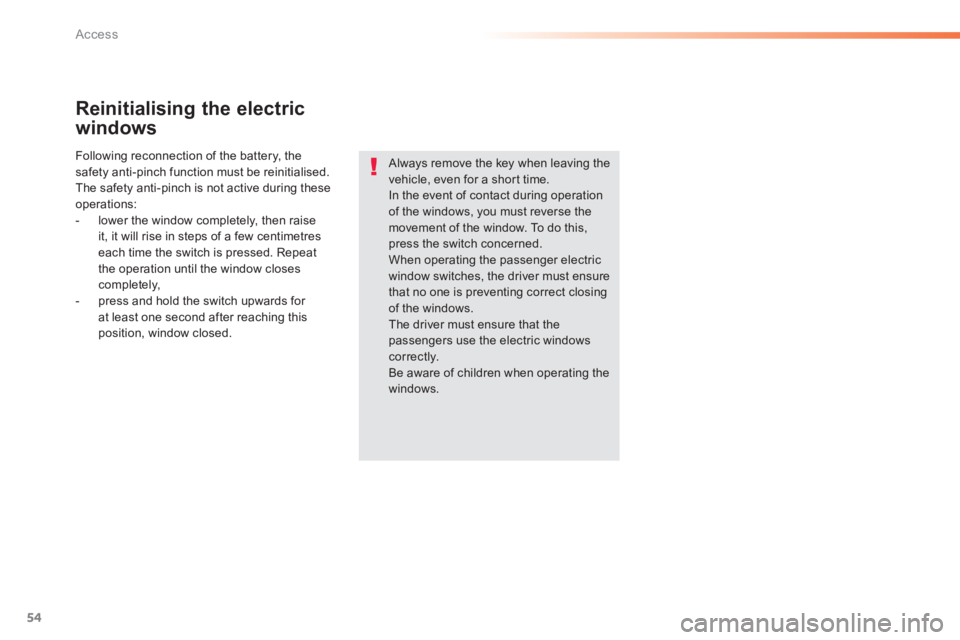
54
Access
Reinitialising the electric
windows
Following reconnection of the battery, the safety anti-pinch function must be reinitialised. The safety anti-pinch is not active during these operations: - lower the window completely, then raise it, it will rise in steps of a few centimetres each time the switch is pressed. Repeat the operation until the window closes completely, - press and hold the switch upwards for at least one second after reaching this position, window closed.
Always remove the key when leaving the vehicle, even for a short time. In the event of contact during operation of the windows, you must reverse the
movement of the window. To do this, press the switch concerned. When operating the passenger electric window switches, the driver must ensure that no one is preventing correct closing of the windows. The driver must ensure that the passengers use the electric windows c o r r e c t l y. Be aware of children when operating the windows.
Page 65 of 336
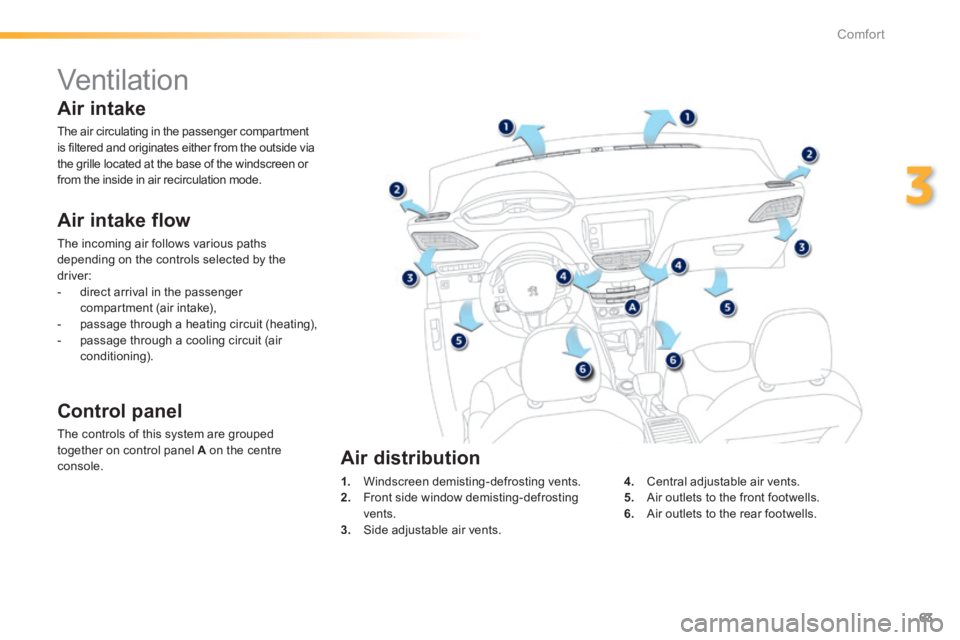
63
3
Comfort
Ventilation
Air intake flow
The incoming air follows various paths depending on the controls selected by the driver: - direct arrival in the passenger compartment (air intake), - passage through a heating circuit (heating), - passage through a cooling circuit (air conditioning).
Control panel
The controls of this system are grouped together on control panel A on the centre console. 1. Windscreen demisting-defrosting vents. 2. Front side window demisting-defrosting vents. 3. Side adjustable air vents.
4. Central adjustable air vents. 5. Air outlets to the front footwells. 6. Air outlets to the rear footwells.
Air distribution
Air intake
The air circulating in the passenger compartment is filtered and originates either from the outside via the grille located at the base of the windscreen or from the inside in air recirculation mode.
Page 68 of 336
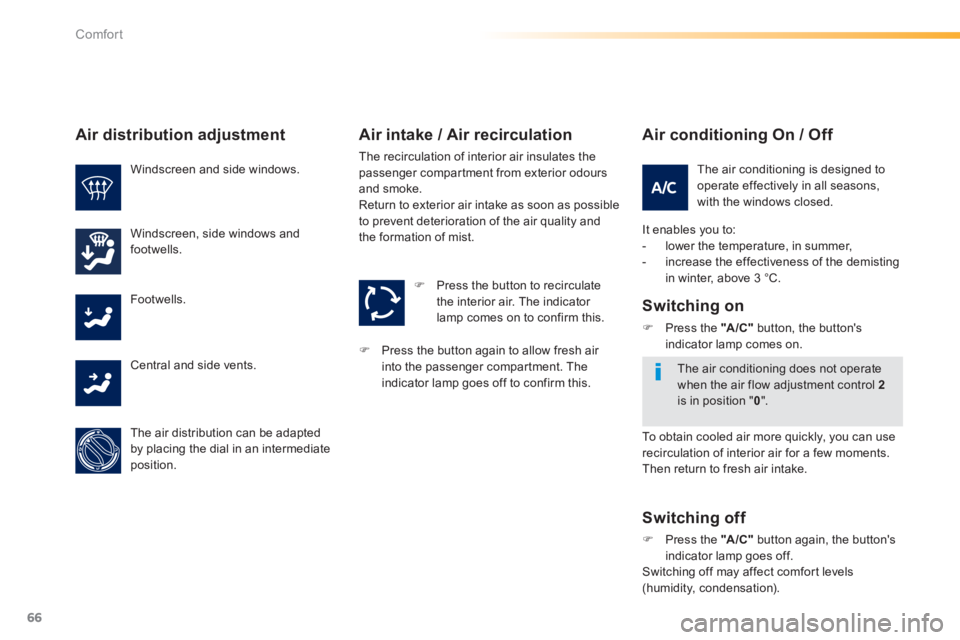
66
Comfort
Air conditioning On / Off
It enables you to: - lower the temperature, in summer, - increase the effectiveness of the demisting in winter, above 3 °C.
Switching on
Press the "A /C " button, the button's indicator lamp comes on.
Switching off
Press the "A /C " button again, the button's indicator lamp goes off. Switching off may affect comfort levels (humidity, condensation).
The air conditioning is designed to operate effectively in all seasons, with the windows closed.
The air conditioning does not operate when the air flow adjustment control 2is in position " 0 ".
To obtain cooled air more quickly, you can use recirculation of interior air for a few moments. Then return to fresh air intake.
Air distribution adjustment
Windscreen and side windows.
Windscreen, side windows and footwells.
Footwells.
Central and side vents.
The air distribution can be adapted by placing the dial in an intermediate position.
Press the button to recirculate the interior air. The indicator lamp comes on to confirm this.
Air intake / Air recirculation
The recirculation of interior air insulates the passenger compartment from exterior odours and smoke. Return to exterior air intake as soon as possible to prevent deterioration of the air quality and the formation of mist.
Press the button again to allow fresh air into the passenger compartment. The indicator lamp goes off to confirm this.